I’ve been starting my vegetable seeds in homemade compost for many years so when I hear someone say that this can’t be done, or shouldn’t be tried, I wonder about their reasons for saying so.
In addition to hearing individual gardeners recommend against starting vegetable seeds in compost, two books that I like both recommend starting seeds in mixes that do not include compost. Rather, the California Master Gardener Handbook and The Complete Guide to Saving Seeds by Robert and Cheryl Gough recommend starting vegetable seeds in mixes that are mostly composed of peat moss and perlite or vermiculite, which are the ingredients of typical bags of seed-starting mix that you buy at a garden center. (See, for example, E.B. Stone’s Seed-Starter Mix.)
I’ve used such seed-starting mixes, and I’ve gotten acceptable starts for my vegetable plants. However, a few years ago I ran a little experiment adding some soil and compost to the peat moss and perlite mix and found that, if anything, my vegetable seedlings ended up bigger and healthier at transplant size. (See my post, “Adding soil and compost to seed-starting mixes.”)
So why is it that these books don’t recommend using compost to start vegetable seeds? Neither actually mentions the option of compost, but both mention the option of garden soil, and both list the same main concern with using garden soil in a container in which to start vegetable seeds: it isn’t sterile.
“It is very important to use sterile media,” says the California Master Gardener Handbook on page 96. And on page 72 of The Complete Guide to Saving Seeds: “Garden soil may also be used, but to prevent contamination of the seeds by soilborne fungi and other pathogenic organisms, be sure to sterilize it first . . .”
Compost, blooming with a diversity of microbes, is far from sterile — especially my homemade compost, which always has a bit of my yard’s soil in it and never heats up enough to kill much of anything.
Do my seedlings fall prey to diseases then? Am I being unwisely risky?
It used to be recommended to start vegetable seeds in compost
I feel outmoded, as most of the other gardeners or gardening books that I’m aware of who also use or recommend the use of compost in which to start vegetable seeds are old.
John Jeavons recommended that we start our vegetable seeds in a mix that is “one part sifted compost and one part bed soil.” This was on page 67 of Jeavons’s book How to Grow More Vegetables, first published in 1974.
And in the original Sunset Western Garden Book published in 1954, it is written on page 84: “Here’s the recipe for a standard compost, suitable for a wide range of seeds: 1 part loam [soil]; 1 part clean river sand; 1 part leaf mold or peat moss.” Leaf mold is compost made of decomposed leaves.
Both old sources recommend basically the same mix, which includes soil and compost. And both have little to nothing to say about sterility. Jeavons says nothing about it while the 1954 Sunset Western Garden Book says, “If you have reason to believe that the soil used in your seed compost may be harboring [fungus] spores or pests, or if you simply like to be on the safe side, you can sterilize the seed mixture.”
Damping off disease
A common reason given for not using, or sterilizing, compost and soil in a seed-starting mix is to avoid the disease called damping off, which is said to be caused by several pathogens. The most common symptom of damping off is where a tiny vegetable seedling emerges only to have its stem shrivel just above ground level, after which the plant soon collapses and dies.
Once while giving a gardening presentation I mentioned that I use my homemade compost in which to grow vegetable seedlings. A woman in the audience asked me how I prevented damping off. “Let me think about that,” I said. “I haven’t seen damping off for a few years. I think it’s that I’ve learned to water the vegetable sowings properly.”
Damping off occurs, just as with any other disease, within the “disease triangle.” The disease triangle is a concept that says that in order to have a disease you must have three things: the pathogen, a plant that is susceptible to the pathogen, and environmental conditions that are friendly to the pathogen. Remove any single side of the triangle and you remove the disease.
My routine when starting vegetable seeds in compost
My routine when starting vegetable seeds in compost does not consider the first two sides of the disease triangle, but it does eliminate the third side — friendly environmental conditions — and that is all that’s necessary.
The University of California’s Integrated Pest Management page for damping off says that conditions are friendly to microbes that cause damping off when seeds are planted in cold wet soil, when soil drainage is poor, when seeds are planted too deeply, and when “green” compost is used. The short of it is that conditions have to be consistently wet, which makes sense since the disease is called damping off.
But we are largely in control of these conditions. My routine is to thoroughly water the compost before sowing and then to almost never water the compost again after sowing seeds and before the seedlings have emerged. I keep my trays of seedlings in full shade, either in my garage or under the shade of a tree. Almost always, the compost maintains enough moisture to germinate the seeds without ever even a light misting.
In other words, I remove the possibility for damping off by not overwatering.
An additional key practice is to move the seedlings into full sun all day long immediately after germination. This is necessary for their continued growth (so they don’t become spindly), and it incidentally helps prevent damping off.
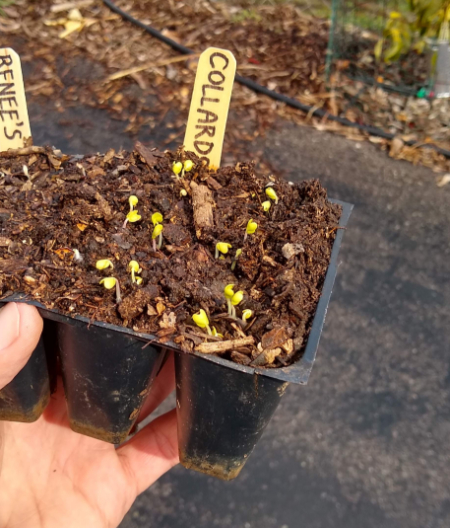
Once the seedlings are in full sun, then you can begin watering as the compost loses moisture from evaporation and from the seedling drawing it out.
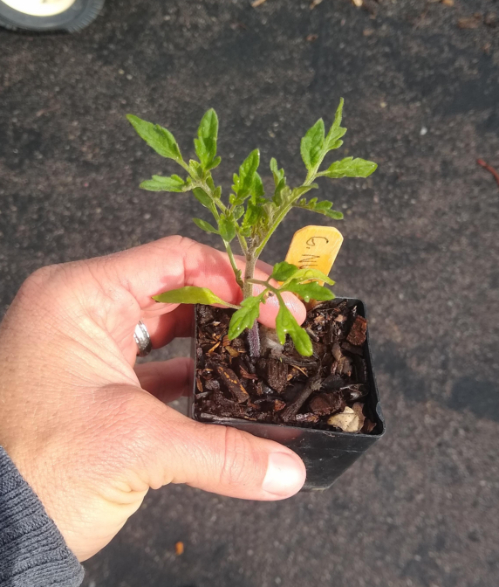
This compost is not that compost
As all composts are different, and there may be some in which vegetable seedlings don’t grow very well, let me mention what mine is generally made of. It’s something I think of as “chicken compost” because it comes from my chicken pen, which is stationed directly over the natural ground in our yard, and which I cover with a bedding of wood chips (at least one foot deep at first). Then over time I add garden scraps, food waste, weeds, urine, and then the chickens add their manure. Sometimes I also add manure from a neighbor’s horses.
In conclusion, I’m not saying that you should start vegetables in compost. I’m only saying that I know firsthand that you can, and that compost can start vegetable seedlings very well. Many other gardeners have been doing so for many years too.
All of my Yard Posts are listed HERE

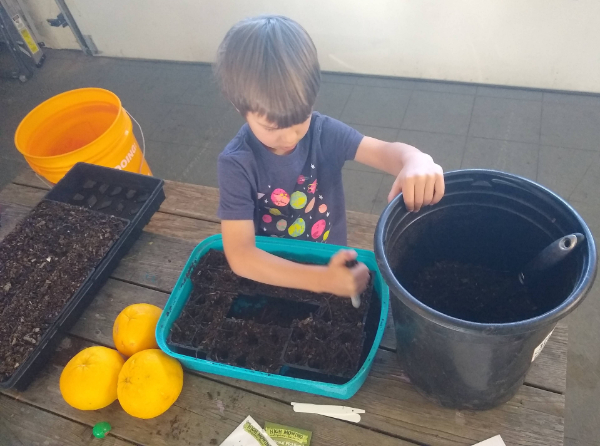
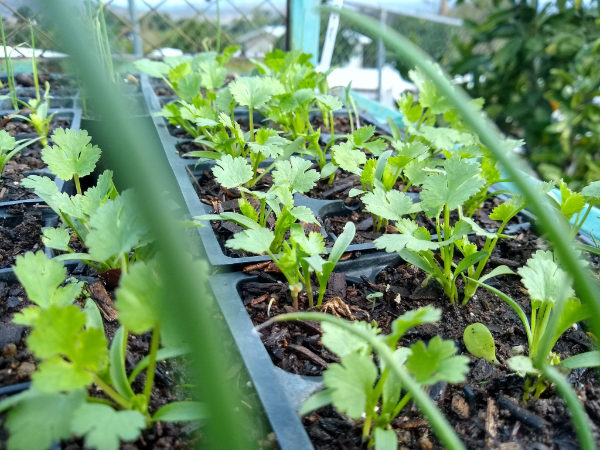

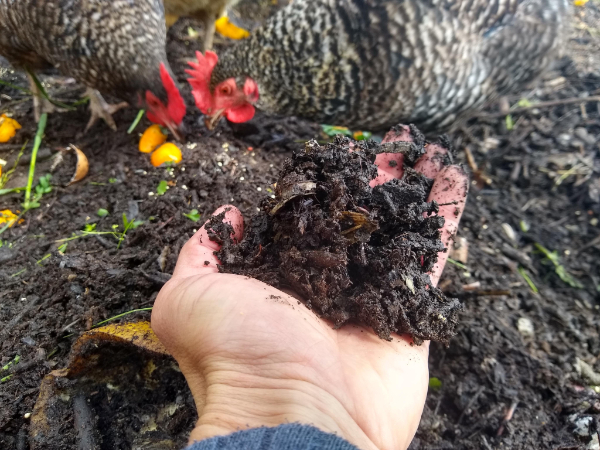


Would manure vs vegetable compost make a difference?
That’s a good question, Neil. I haven’t made any compost that didn’t include manure for quite a while. I’ll get a little side-by-side comparison started though.
I do know that experienced people have strong preferences in opposite directions. For example, John Jeavons (mentioned above) prefers no manure whereas Albert Howard preferred including manures.
In the comment below, Holly mentions Charles Dowding of England, and I know that he adds manure to his composts. Also, on page 30 of his “Vegetable Garden Diary” book he shows lettuce sown into four different kinds of compost. The ones that include manure grew the best.
Great post! Thank you!
I admit to preferring a finer and lighter mix to start seeds, but I transplant into 4” pots using a mix of 2/3 compost and 1/3 generic potting soil or compost with a bit of vermiculite added. I have had trouble with straight compost getting waterlogged by rains on seedlings out for full sun and losing a whole batch.
I recently saw advice to use diluted black tea rather than water to wet the starting mix and water seedings to avoid fungal disease. Do you have any research on that?
Hi Beth,
Your routine sounds very sensible to me. I’ve never heard of the diluted black tea idea. Wonder if it’s supposed to kill fungi?
Thanks for this very interesting post. I’ve actually been thinking a lot about this over the past year. My mom is an amazing gardener, and she taught me to start seedlings in a mix of garden soil and home-made compost. We had no trouble, and I never encountered damping off back then. I follow a ton of gardeners on YouTube, and a lot of the ones from other countries (especially the U.K. and Australia) pretty much only talk about starting seeds in compost. For example, that’s what the great Charles Dowding does. So, I find it really weird that Americans tend to obsess over sterile seed-starting media. I just stick to watering properly and making sure my seedlings get enough sun, like you mentioned. I’ve lost maybe 2 or 3 seedlings to damping off in my adult life, but that was when I didn’t pay attention and overwatered.
Hi Holly,
Thanks for this. It’s good to hear that others nearby have similar experiences.
My compost is loaded with rollie pollies who love to eat seedlings.
Hi Karen,
That’s one benefit of making my compost in the chicken pen: bug free. However, if I leave a container of finished compost on the ground for a few days while I’m using it for sowing seeds, then the rollie pollies find it so as I pour it into the modules or trays I have to keep an eye out for them and pick them out.
I have used organic top soil, store bought chicken manure and covered the vegetables with wood chips but gnats have taken over. Some of the vegetables are not growing as fast as others and they don’t look happy and strong here in poway. Please help!
Thanks
Hi Elmira,
Take the seedlings out into the sun and breeze for a while. Keep an eye to make sure they stay moist. Out there the gnats will not find it hospitable and will likely go away. You might also temporarily remove the wood chips in order to dry out the surface a bit.
Are the people that are using sterile media starting their seeds indoors? If so, maybe they’re trying to avoid fungus gnats? This year I started seeds indoors using sterile media. To me the sprouts are not looking very robust in comparison to when I’ve used compost mixed in. I might have to start over – and just deal with the gnats.
i’ve pulled out mangos and avocados that have started in worm castings in my worm bag, constantly germinating plants from seeds that get tossed in there problem is they get leggy if I don’t open the bag and take them out in time but I bet pure castings is wonderful for plants to start in if you had enough.
hey Greg you should start a MANGO post, I know you’ve had your troubles and I had my prize possession die on me but we have to keep trying!!! lol I have a manilla growing nicely now. If I try a fancy cultivar I’m definitely going to try more sand. Someone posted you can grow them and avocados in pure sand and just top dress with compost and organics. I might try a mound of sand and then cover in compost.
Hi Greg, Very interesting. As often is the case when advocating a gardening practice, a tempest brews! Did you mention home compost if free and is environmentally friendly (vs peat or pearlite)? Thanks for sharing the research and reminding us(me) about the disease triangle. I just moved my composter away from the house onto my slope, as I could not get rid of a mischief of mice.
I have always just thrown potting soil in starter trays and hoped for the best. Now that I am growing more vegetables I may have to look for a better way to start my seeds because my success rate on certain vegetables is pretty poor.
One thing I noticed are seeds germinate like crazy in my worm bin which started off as coco coir and now it’s all coir and castings. All my seedling avocados and mangos I have pulled out of my worm bin so I’m thinking of using the stuff in my worm bin (using a screen to filter out the worms and kitchen scraps).
Saw a video on Youtube where a person was creating “soil cubes/blocks” that he would start his seeds in. Something about the rough handling of seedlings as you transfer them to garden or container is supposed to have some kind of impact but with these soil blocks it’s just plug and play. Just pop the cube into the soil you are growing in and they are supposed to be much more healthy and grow faster. Probably something I won’t bother trying but it was interesting to note.
Thank you for sharing these helpful tips and hacks about seed planting. it was really helpful knowing how to plant properly.
Just used your method part compost part soil. The compost mixed in was very wet so I don’t plan on watering. Should I do without the “greenhouse effect” clear top that my tray came with??
Hi Diesel,
I don’t use the top. I find that it actually keeps things too moist and promotes “damping off” disease. I just keep an eye on the soil moisture and water after a few days (or a few weeks) if necessary.
Hi Greg, stumbled over your web page while looking for info on this subject.
In my opinion, the world is going backwards thinking that they are outsmarting
nature by introducing something that is not natural and of course
there’s always money to be made with anything one markets well.
I’m no expert gardener and have gone the whole round from
planting in soil only (guess I didn’t read much about it then) to
coco coir + compost/vermicompost and after reading your info, I will move
more in the direction of pure compost/vermicompost as I produce it
in my garden. I just have to take better care to use finished compost and
sift it better. I was always wondering what people hundreds of years ago used.
One question – I’m still not there with the watering. I basically drown
the pot with water and leave it alone till the seeds germinate but
if I leave the pot in a warm place, seeds which take a long time
will then be in dry compost – how do you handle this ?
Also, once I put the pot in direct sunlight (I’m in zone 9/Mediterranean
climate – sun is beating down well even today), the soil (compost/coir) dries
quickly – how often should I water and how (from top/bottom) and how much
– I’m always afraid the plant will dry out?
I appreciate your ideas here, Vjekoslav. I find watering tricky too.
My routine is to totally saturate the compost at sowing time, and then I rarely need to add water until after germination. But if I use a heating pad underneath or keep the tray in a very warm spot, then the compost often dries before germination so I have to add water.
How do I know if it needs water? I lift the tray to check the weight, and I touch the surface to feel if it is sticky. A wet tray is heavy, and a moist compost is sticky.
If it needs water, I gently sprinkle from the top using a measuring cup or a small (child’s) watering can.
After germination and the seedlings are in direct sun, I check for water needs only by lifting the tray. If the seedlings need water, I usually water from the top, but sometimes I also fill a larger tray and let the compost soak up water from the bottom too.
When it’s a warm time of year, I find that seedlings need water at least once each day. How often to water depends on the weather, but even more than that it depends on how big the plant is compared to how big is the container in which it sits. A big plant in a little container sucks out the moisture reserves in that small volume very quickly so it needs water added much more often than a small plant in a large container.
Hi Greg, appreciate the feedback ! you’ve enlightened me regarding the
obvious – sometimes, one needs to observe and think carefully 😉
You’ve helped a lot – now back to work more on the compost/sifting
practice the watering
Hi Greg, always learn so much from your posts. I like the idea of the chickens cleaning the bugs out of the compost. I’ve heard that chicken manure needs to be aged at least six months to avoid burning the plants. How does that work in the chicken pen when they’re constantly adding fresh poop? How do you get “finished” compost?
Hi Ann,
Aging the compost only matters if you’re using it to start seeds or mix into a planting hole. I let my compost sit for a month or more before using it to start seeds. I just let it sit in five- or fifteen-gallon plastic containers. This “finishes” it, you could say.
But if I’m using it to fertilize vegetable beds or fruit trees, then I just spread the compost on the surface and I don’t let it sit before spreading it. I’ve never seen a problem after doing this.
I’ve noticed this year that surviving garbage seeds in my compost pile start and grow much more healthy than those I intentionally planted in starting kits using purchased starting soil. So I’m beginning to experiment using more compost. My compost never gets hot. It just decomposes over time and looks like clean dirt the consistency of sand,very little showing of larger particles.
Is the seed starting mix in your trials non-nutritive? I don’t think you’re supposed to keep it in that through transplant, or at least I never have. I use the little peat pellets and drop them in a cup/pot of potting soil as soon as the seed germinates. The bagged potting soil is finer than compost/regular dirt, has good drainage, and probably has fewer fungal spores and bacteria– not ideal for long-term healthy soil but good for when the seedlings are small and defenseless and need their energy to survive in the too-cold, not bright enough place I started them. I’m mostly thinking of fragile seedlings like tomatoes, peppers, and eggplant. Stuff like beans and curcurbits that forms a bigger, faster-growing seedling right out of the gate seems like you can start it in whatever, especially if you soak first.